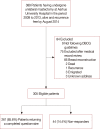Persistent Pain after Breast Cancer Treatment: A Questionnaire-Based Study on the Prevalence, Associated Treatment Variables, and Pain Type
- PMID: 28053634
- PMCID: PMC5204052
- DOI: 10.4048/jbc.2016.19.4.447
Persistent Pain after Breast Cancer Treatment: A Questionnaire-Based Study on the Prevalence, Associated Treatment Variables, and Pain Type
Abstract
Purpose: Persistent pain is a common side effect of breast cancer treatment. The present study aimed to assess the prevalence, associated treatment-related factors, and the type of pain (neuropathic or nociceptive) in patients who had undergone a unilateral mastectomy.
Methods: All women who underwent a unilateral mastectomy at a University Hospital between 2009 and 2013 were eligible for inclusion. Women with breast reconstruction or active cancer were excluded. Participants were mailed a questionnaire evaluating the prevalence, location, intensity, and frequency of surgical site pain. Additionally, the painDETECT®, a validated instrument to evaluate neuropathic pain, was mailed to all participants.
Results: A total of 305 women were included, and of them, 261 (85.6%) completed the study questionnaire. After a median follow-up period of 3.0 years, 100 women (38.3%) reported experiencing pain at the surgical site. Body mass index ≥30 kg/m2, radiation therapy, and axillary lymph node dissection were significantly associated with persistent pain in univariate models. However, only body mass index ≥30 kg/m2 was independently associated with persistent pain (odds ratio, 2.13; 95% confidence interval, 1.06-4.27; p=0.034) in a multivariate analysis. Of the patients reporting pain, 71.0% were unlikely to have a neuropathic pain component. A moderate, but highly significant, positive correlation was observed between the pain intensity and the painDETECT® score (rs=0.47, p<0.001).
Conclusion: Persistent pain after breast cancer treatment continues to have a high prevalence. Our results indicate that the largest proportion of patients experiencing persistent pain after breast cancer treatment do not have a clear neuropathic pain component.
Keywords: Breast neoplasms; Chronic pain; Mastectomy; Neuralgia.
Conflict of interest statement
The authors declare that they have no conflict of interests.
Figures
References
-
- Andersen KG, Kehlet H. Persistent pain after breast cancer treatment: a critical review of risk factors and strategies for prevention. J Pain. 2011;12:725–746. - PubMed
-
- Mejdahl MK, Andersen KG, Gärtner R, Kroman N, Kehlet H. Persistent pain and sensory disturbances after treatment for breast cancer: six year nationwide follow-up study. BMJ. 2013;346:f1865. - PubMed
-
- Gärtner R, Jensen MB, Nielsen J, Ewertz M, Kroman N, Kehlet H. Prevalence of and factors associated with persistent pain following breast cancer surgery. JAMA. 2009;302:1985–1992. - PubMed
-
- Belfer I, Schreiber KL, Shaffer JR, Shnol H, Blaney K, Morando A, et al. Persistent postmastectomy pain in breast cancer survivors: analysis of clinical, demographic, and psychosocial factors. J Pain. 2013;14:1185–1195. - PubMed
LinkOut - more resources
Full Text Sources
Other Literature Sources


